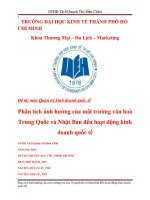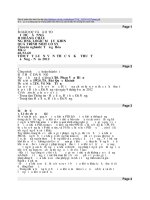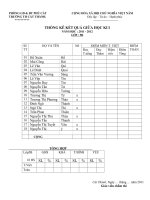UBI-GM-Presentation18.050112-price pps
Bạn đang xem bản rút gọn của tài liệu. Xem và tải ngay bản đầy đủ của tài liệu tại đây (3.25 MB, 27 trang )
Pricing for International Markets
Chapter 18
McGraw-Hill/Irwin © 2005 The McGraw-Hill Companies, Inc. All rights reserved.
PowerPoint presentation prepared by:
Alfred Lowey-Ball
Associate Professor of Marketing
UBI-United Business Institutes
Brussels, Belgium
Chapter Outline
•
Pricing Policy
•
Approaches to international pricing
•
Full cost vs variable cost pricing
•
Skimming vs penetration pricing
•
Price escalation
•
Cost of exporting Deflation
•
Tax, Tariff, admin costs Exchange rate fluctuations
•
Inflation Varying currency values
•
Middlemen and transportation costs
•
Sample effects of price escalation
•
Lessening Price escalation
•
Leasing in international markets
•
Countertrade
•
Transfer Pricing
•
Price Quotations
•
Administered pricing
•
Pricing Policy
•
Approaches to international pricing
•
Full cost vs variable cost pricing
•
Skimming vs penetration pricing
•
Price escalation
•
Cost of exporting Deflation
•
Tax, Tariff, admin costs Exchange rate fluctuations
•
Inflation Varying currency values
•
Middlemen and transportation costs
•
Sample effects of price escalation
•
Lessening Price escalation
•
Leasing in international markets
•
Countertrade
•
Transfer Pricing
•
Price Quotations
•
Administered pricing
Introduction
Pricing strategy is one of the most critical and complex
issues in global marketing (due to economic,
financial, and mathematical implications)
Remember price is the only marketing mix element that
generates revenues. All other elements entail costs
The marketing manager’s fiduciary responsibility is to
market products at a profit and increase shareholder
wealth, so price with care
A company’s global pricing policy may make or break its
overseas expansion efforts (due to foreign exchange
complications)
Firms face significant challenges in coordinating
(standardizing or adapting) their pricing strategies
across various countries they operate in
Pricing Objectives
•
In general, price decisions are viewed in
two ways:
–
Pricing as an active instrument of
accomplishing marketing objectives, or
–
Pricing as a static element in a business
decision
•
The more control a company has over the final selling price of a product, the
better it is able to achieve its marketing goals
•
The more control a company has over the final selling price of a product, the
better it is able to achieve its marketing goals
•
It is not always possible to control end prices
•
It is not always possible to control end prices
•
Broader product lines and the larger the number of countries involved, the
more complex the process of controlling prices charged to the end user
•
Broader product lines and the larger the number of countries involved, the
more complex the process of controlling prices charged to the end user
Approaches to International Pricing
1. Full-Cost Pricing: no unit of a similar product is different from any other unit in
terms of cost, which must bear its full share of the total fixed and variable cost.
•
There are several approaches to pricing in international
markets, which include:
•
There are several approaches to pricing in international
markets, which include:
2. Variable-Cost Pricing: firms regard foreign sales as bonus sales and assume
that any return over their variable cost makes a contribution to net profit
•
Prices are often set on a cost-plus basis, i.e., total costs plus a
profit margin
•
Prices are often set on a cost-plus basis, i.e., total costs plus a
profit margin
•
This is a practical approach to pricing when a company has
high fixed costs and unused production capacity
•
This is a practical approach to pricing when a company has
high fixed costs and unused production capacity
Approaches to International Pricing
3. Skimming Pricing: This is used to reach a segment of the market that is
relatively price insensitive and thus willing to pay a premium price for a
product
4. Penetration Pricing: This is used to stimulate market growth
and capture market share by deliberately offering products at
low prices
•
It is used to acquire and hold share of
market
•
It is used to acquire and hold share of
market
Price Quotations
•
« Price » always means « Price + Terms »
•
Budget or Indicative price
•
Firm Price, valid for how long?
•
Price is the most significant item in any contract for sale
•
Terms typically include:
•
product description quantity and quality
•
packaging mode of transport
•
delivery conditions payment terms
•
time & place of delivery
Price Calculation & Escalation
Price Calculation & Escalation
Comments on escalation
•
Price escalation is the term for the added costs incurred for exporting,
and includes costs for shipping, insurance, packing, tariffs, longer
channels of distribution, higher middlemen margins, special
taxes and admin costs, and exchange rate fluctuations
•
End prices to consumers for US products often up to 2x as high
•
Prices difficult for manufacturer to control in foreign markets
•
Almost impossible to absorb price add-ons at manufacturer’s level
•
Cost containment becomes a priority
•
Solution for many consumer items: manufacture abroad; shut down US
manufacturing
McGraw-Hill/Irwin © 2005 The McGraw-Hill Companies, Inc. All rights reserved.
Price War in Brazil
•
P&G introduced low-cost « Pampers Uni »
disposable diapers into Brazil in the nineties
•
Initially a boom market. Product had to be
brought in. The economics were right:
population wealthier.
•
shortly thereafter Kimberly Clark (with its
partner Unilever) came with its « Huggies »
product, rapidly gaining mkt share
•
P&G cut prices by 10 – 15%; Carrefour came still
lower with « Bibi Pipi »
•
Lower prices and hi volumes brought low cost
local suppliers into the market.
No
one
wins!
Approaches to Lessening Price Escalation
Methods used to reduce costs and, thus, lower price escalation include:
Methods used to reduce costs and, thus, lower price escalation include:
•
Lowering Cost of Goods: Firms can lower costs by
eliminating costly features in products or by
manufacturing products in countries where labor costs are
cheaper
•
Lowering Tariffs: Firms can lower prices by categorizing
products in classifications where the tariffs are lower
•
Lowering Distribution Costs: Firms can design channels
that are shorter, have fewer middlemen, and by reducing or
eliminating middleman markup
•
Using Foreign Trade Zones: Firms can manufacture
products in free trade zones where the incentive offered is
the elimination of local taxes, which keep prices down
Parallel Importation or Gray Markets
•
On account of competition, firms may have to charge different
prices from country to country
•
In international marketing, this causes a vexing problem:
Parallel Importation or Gray Markets
•
Parallel imports develop when importers buy products from
distributors in one country and sell them in another to
distributors who are not part of the manufacturer’s regular
distribution system
•
The possibility of a parallel market occurs whenever price
differences are greater than the cost of transportation between
two markets
Parallel Importation or Gray Markets
•
For example, the ulcer drug Losec sells for only $18 in Spain
but goes for $39 in Germany; and the heart drug Plavix costs
$55 in France and sells for $79 in London
•
Thus, it is possible for an intermediary to buy products in
countries where it is less expensive and divert it to countries
where the price is higher and make a profit
•
Exclusive distribution, a practice often used by companies to
maintain high retail margins encourage retailers to stock large
assortments, or to maintain the exclusive-quality image of a
product, can create a favorable condition for parallel importing
Effects of Parallel Importation
•
Parallel imports can do long-term damage in the market for
trademarked products
•
Customers who unknowingly buy unauthorized imports have
no assurance of the quality of the item they buy, of warranty
support, or of authorized service or replacement parts
•
If a product fails, the consumer blames the owner of the
trademark, and the quality image of the product is sullied
•
Companies can restrict the gray market by policing distribution
channels
•
In some countries firms get help from the legal system
Currency Conditions
Stress, price benefits
Expand product line and add more
costly features
Shift sourcing and manufacturing to
domestic market
Exploit export opportunities in all
markets
Conduct conventional cash-for-
goods trade
Use full-costing approach, but use
marginal-cost pricing to penetrate
new/competitive markets
When Domestic Currency is
WEAK
Engage in nonprice competition by
improving quality, delivery, and after-
sale service
Improve productivity and engage in
vigorous cost reduction
Shift sourcing and manufacturing
overseas
Give priority to exports to relatively
strong-currency countries
Deal in countertrade with weak-
currency countries
Trim profit margins and use marginal-
cost pricing
When Domestic Currency is
STRONG
SOURCE: S. Tamur Cavusgil, "Unraveling the Mystique of Export Pricing,"
Business Horizons, May-June 1988, figure 2, p. 58.
Export Strategies Under Varying
Currency Conditions
SOURCE: S. Tamur Cavusgil, "Unraveling the Mystique of Export Pricing,"
Business Horizons, May-June 1988, figure 2, p. 58.
Speed repatriation of foreign-earned
income and collections
Minimize expenditures in local, host
country currency
Buy needed services (advertising,
insurance, transportation, etc.) in
domestic market
Minimize local borrowing
Bill foreign customers in domestic
currency
Keep the foreign-earned income in
host country, slow collections
Maximize expenditures in local, host
country currency
Buy needed services abroad and pay
for them in local currencies
Borrow money needed for expansion
in local market
Bill foreign customers in their own
currency
When Domestic Currency is
WEAK
When Domestic Currency is
STRONG
•
Leasing opens the door to a large segment of nominally
financed foreign firms that can be sold on a lease option but
might be unable to buy for cash
•
Leasing opens the door to a large segment of nominally
financed foreign firms that can be sold on a lease option but
might be unable to buy for cash
•
Lease revenue tends to be more stable over a period of time
than direct sales would be
•
Lease revenue tends to be more stable over a period of time
than direct sales would be
•
Equipment leased and in use helps to sell other companies in
that country
•
Equipment leased and in use helps to sell other companies in
that country
•
Leasing helps guarantee better maintenance and service on
overseas equipment
•
Leasing helps guarantee better maintenance and service on
overseas equipment
•
One approach classifies
international shipments as
dumped if the products are
sold below their cost of
production
•
The other approach
characterizes dumping as
selling goods in a foreign
market below the price of
the same goods in the home
market
Economists define dumping
differently
Economists define dumping
differently
•
World Trade Organization
(WTO) rules allow for the
imposition of a duty when
goods are dumped
•
A countervailing duty or
minimum access volume
(MAV), which restricts the
amount a country will
import, may be imposed on
foreign goods benefiting
from subsidies whether in
production, export, or
transportation
Countertrade as a Pricing Tool
1. Barter: is the direct exchange of goods between two parties in a transaction
2. Compensation deals: is the payment in goods and in cash
3. Counter-purchase or off-set trade: the seller agrees to sell a product at a
set price to a buyer and receives payment in cash and may also buy goods
from the buyer for the total monetary amount involved in the first contract or
for a set percentage of that amount, which will be marketed by the seller in
its home market
4. Buy-back: This type of agreement is made the seller agrees to accept as
partial payment a certain portion of the output that are produced from the
plant or machinery that are sold to the buyer
•
Countertrade is a pricing tool that every international marketer
must be ready to employ
•
Countertrade is a pricing tool that every international marketer
must be ready to employ
•
There are four distinct transactions in countertrading, which
include:
•
There are four distinct transactions in countertrading, which
include:
Proactive Countertrade Strategy
1. Is there a ready market for the goods
bartered?
2. Is the quality of the goods offered
consistent and acceptable?
3. Is an expert needed to handle the
negotiations?
4. Is the contract price sufficient to
cover the cost of barter and net the
desired revenue?
Answering the following questions is suggested before entering
into a countertrade agreement:
Answering the following questions is suggested before entering
into a countertrade agreement:
Why Purchasers Impose Countertrade Obligations
•
To Preserve Hard Currency
•
To Improve Balance of Trade
•
To Gain Access to New Markets
•
To Upgrade Manufacturing Capabilities
•
To Maintain Prices of Export Goods
•
To Force Reinvestment of Proceeds









